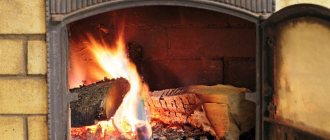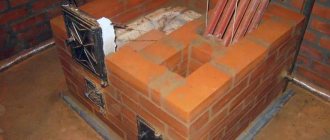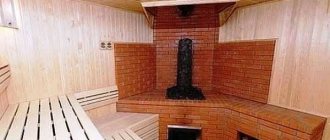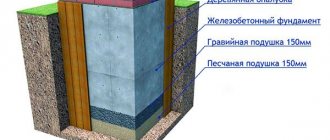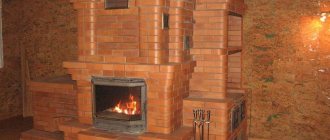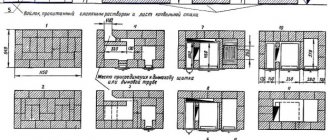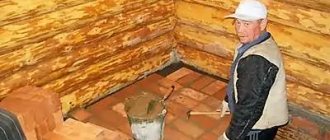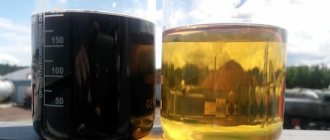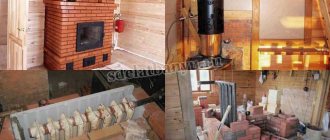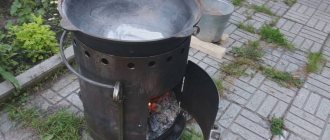Where to start: the preparatory stage of work
Work begins with a careful inspection of the structure in the ceiling area. In old houses, Russian stoves, as a rule, were built along with the house and used as additional ceiling supports. You can begin dismantling only after making sure that the roof does not rest on the chimney, and its structure will not be damaged after dismantling the ducts.
Outdated stove
Dismantling a stove is a dirty and dusty job. If you have to do it not at the stage of a major overhaul, you need to remove everything that is possible from the room and cover the remaining pieces of furniture with film. You can also build something like curtains from thick polyethylene, separating the desired area from the rest of the room.
The easiest ways to remove
The choice of the optimal method for removing whitewash from the ceiling depends, first of all, on the total area of the room in which the work will take place. If its square footage is small, the traditional dry method is quite suitable.
Dry
A spatula is the simplest and most effective tool in the fight against outdated whitewash
It requires the use of a wide metal spatula, thanks to which it will be possible to remove the whitewash from the ceiling layer by layer. In this case, any irregularities that arise can be smoothed out with sandpaper. The advantage of this method is its simplicity and the absence of the need to purchase additional means for removing the old coating. But the disadvantages are labor-intensive, time-consuming and a huge amount of dust.
However, you can get rid of them:
- placing a special box on the spatula. It can be purchased at a hardware store along with the spatula or scraper itself, or you can make it yourself. The uniqueness of this device is that it allows you to avoid dust settling on all surfaces. You can replace it with any container.
- using a grinding machine. It allows you to speed up the whitewash removal process without losing quality and is ideal for large areas.
- gradually applying water with a spray bottle or a wet sponge to the layers of whitewash. Once they are soaked, they can be easily removed with a spatula, thus avoiding the appearance of a cloud of dust. In this case, you can replace the spatula with a scraper.
When choosing this method, you should not soak the entire ceiling area at once. It is much wiser to divide it into several sections and process them in turn. As a rule, the process of wetting the whitewash layer takes 5-10 minutes.
This method is best used in small rooms or in rooms with a small layer of whitewash to avoid the appearance of a large amount of dirt. Meanwhile, its occurrence can also be prevented by simply wiping the swollen layer of whitewash with a damp cloth.
- “tapping” evenly with an ordinary hammer on the old whitewash, especially if it is calcareous and thick. Peeling pieces can be easily removed with a spatula.
Wet
For many years, a wet sponge has remained one of the most popular tools for removing whitewash.
Tools: necessary tools
The set of tools for dismantling brickwork depends on the composition used for the construction of the mortar. Here is a list of tools that will most likely be needed for the job:
- heavy hammer or sledgehammer,
- scrap,
- pick,
- chisel,
- hammer drill,
- steel wedges.
It is recommended to work in a respirator and use gloves to protect your hands. It’s better to choose clothes that you don’t mind throwing away. During disassembly, not only dust will fly, but also soot, and washing it off is very problematic.
Toyota Camry 1997, 140 l. With. - with your own hands
Cars for sale
Toyota Camry, 1997
Toyota Camry, 1996
Toyota Camry, 1996
Toyota Camry, 1995
Comments 18
I cleaned everything, there was compressed dust just like I pulled the felt out of there, this is the first time I’ve seen this... If you have a compressor, you can also blow it out with it!
So a toothbrush is not a problem, I asked the guy to go look for a bottle for me while I was at work! And there is a remedy called a thousand, can it replace this remedy if it is not available?
And of course, if you remove the dashboard and remove all the pipes and channels and rinse them with hot water in the bathroom at home, and blow out the radiator with a compressor - this is of course the best and most effective option!
Helpful information
The easiest way to work is with buildings made of clay, which becomes pliable after preliminary soaking. Depending on the strength of the masonry, a suitable tool is used in the work, for example, a chisel and a hammer. The point should be directed into the masonry joints - this will not only simplify the work, but also reduce the amount of debris, and also help preserve building materials for later use.
The most difficult thing to disassemble is cement masonry; in this case, soaking the seams will not help. For dismantling, steel wedges are driven into the horizontal seams with a sledgehammer, violating their integrity. After this, the masonry is dismantled row by row using a hammer drill, and if there is no such tool, then they use a crowbar.
Dirty cabin filter
A clogged cabin filter greatly affects the operation of the air conditioner in the summer, but can be the reason why the stove does not heat in the winter. It is good when the filter is located in an accessible place (for example, behind the passenger glove compartment) and is changed regularly. But sometimes it is hidden deep in the depths of the center console, and the car owner does not even know about its existence. As a result, instead of a filter, a “bed” of dust, leaves and insects is formed there.
Regularly replacing the cabin filter is important not only for the heater, but also for human health, because passengers breathe the air passing through it. Car manufacturers recommend changing the cabin filter every 10,000 km. And if you often drive on dusty dirt roads, then the replacement interval should be halved.
How to disassemble a chimney
Most often, in one-story houses, the pipe leaves the furnace and is led outside through the ceiling and roof. Less common are complex smoke circulation channels located in the walls of a building. Sometimes you can find an external chimney rising next to the wall.
Dismantling begins with the pipe
The easiest way is to dismantle the pipe coming out of the furnace. It will not be difficult to remove the metal pipe, after first loosening it in different directions.
If the pipe is made of brick, it is carefully disassembled brick by brick, moving from top to bottom and trying not to damage the ceilings and walls. Dismantling begins from the area rising above the roof. To lay the outer part of the pipe, cement is always added to the solution, so it will be more difficult to work here than with other areas. It is even more difficult to disassemble plastered bricks, but what should add strength is that further work will go faster and easier.
Having completed disassembling the outer pipe, they smoothly move into the attic. But first, they cover the resulting hole in the roof with a sheet of roofing iron or cover the roof with the same material that covers the entire roof. To prevent the plaster on the ceiling from collapsing, it is recommended to make grooves around the perimeter of the pipe from the side of the room. Seams made of sand-clay mortar can be easily broken with a chisel and hammer.
Part of a pipe in the attic
When is it necessary to clean the chimney?
Regardless of the quality of the stove, the chimney will still have to be cleaned at some point. It is the matter of time. With proper installation of a stove or fireplace, you can do without this procedure for many years, especially if you use dry firewood and refrain from burning household waste. Firewood must be stored for at least a year and a half before being consumed. The type of wood is also important.
When using pine or spruce firewood, cleaning will be required faster (due to the presence of resin). The first signal of a clogged stove (fireplace) chimney pipe is dark smoke from combustion products. If hardwood firewood or pellets are used, the smoke is clear, sometimes white. Its darkening indicates the accumulation of soot, carbon deposits and dirt. The second sign is that the firewood does not make any noise while burning, the flame becomes dark orange. When these signs appear, it’s time to think about calling a chimney sweep or getting ready to clean it yourself.
But before you clean the chimney yourself, it is still better to inspect the pipe first.
A cleaning weight with a diameter corresponding to the size of the chimney should be in every home. If it easily passes into the pipe, then the reason for the poor operation of the stove is something else. If the weight stops in one place, then the pipe is clogged and the duties of a chimney sweep cannot be avoided.
However, there are folk remedies that allow you to delay this work.
The most ancient folk method is to place raw potato peelings (or chopped raw potatoes) into a heated oven.
When they burn, starch is released, which softens the soot deposit. One part of the deposits flies out through the pipe, the other falls into the stove (fireplace). To prevent the formation of soot deposits, you can also burn rock salt at the same time as firewood.
The most reliable, but also dangerous method is to place a good armful of aspen logs into a heated stove without closing the door. The stove will begin to hum, the soot will ignite, and a flame will appear from the chimney. This method can be used if the chimney is really very reliable.
Features of dismantling the furnace walls
Having completed the work in the attic, they proceed to dismantling the stove in the house. There is no need to rush to remove the doors - it is better to close them tightly to prevent soot from entering the room. Some inexperienced craftsmen make a common mistake and try to speed up the process by breaking the masonry at the bottom of the structure - this cannot be done, since the heavy brick structure can collapse and damage the floor covering.
Another mistake that is also made by non-professionals who want to speed up the process is removing the stove from the room without dismantling the masonry. Indeed, if the hearth is on a foundation and the first row is made without mortar, this is possible. But a standard stove weighs several tons, so only a few people can lift it and carry it without dropping it. In this case, you need to carry the load correctly so that the structure does not fall apart along the way. Considering that during operation, the masonry weakens significantly, the risk that the stove will collapse and cause damage to the floor is very high.
It is better to act slowly, gradually dismantling the walls, moving in a circle. If the structure is tiled, you will first have to get rid of the cladding using a hammer drill. You don’t have to completely remove the plaster, but you will have to clean it at the seams. Naturally, the smaller the stove and the simpler the design of the heating center, the faster the process will go.
The structure is being dismantled row by row
When working with a Russian stove, difficulties arise when dismantling the vault - here it is recommended to place a sheet of iron and make supports so that the structure does not collapse prematurely. It is best to disassemble the vault from the rear wall.
If the furnace has a separate foundation, then it should also be dismantled. A brick or stone foundation can be easily destroyed with a crowbar, and a concrete slab can be broken with a jackhammer.
Before you begin dismantling the stove in your home yourself, it is recommended to weigh all the benefits and risks. Sometimes calling a professional with special equipment is cheaper than eliminating the consequences of trying on your own.
How to flush a stove radiator without removing it
Prepare everything you need
Almost everything you need for cleaning can be found in any garage, or purchased in addition at the nearest auto and household store.
- 150–200 g citric acid;
- bucket for 8–10 l;
- container for draining antifreeze;
- hose about 3 m long;
- clamps;
- wires;
- mesh, gauze or nylon;
- water;
- antifreeze for topping up;
- transfer pump;
- boiler or stove;
- spanners;
- screwdrivers.
Understand the essence of the process
The principle of flushing the stove radiator is as follows. The heater is disconnected from the cooling system and a pump with hoses is connected to it. The chemical is dissolved and heated in a separate container, and then the flushing liquid is circulated through the radiator using a pump. This allows you to dissolve and wash away all accumulated dirt.
To prevent garbage from getting inside again, it is collected and removed at the exit using an improvised filter made of gauze or old nylon tights. Then the radiator is washed with clean water and the standard cooling system hoses are installed in place.
Remove the terminals from the battery
When removing the radiator hoses, you may have to disconnect several wiring connectors. Therefore, in order to avoid errors in the control system, it is better to de-energize the on-board network by removing the terminals from the battery. First negative, then positive.
First make sure that the heater is set to maximum heat. If the control is carried out using a tap, then in the closed position it will block the flow of liquid and interfere with flushing.
Drain the coolant
The heater is filled with antifreeze. To prevent liquid from leaking onto the floor when you remove the pipes, you need to drain it into a previously prepared container through the plug on the main radiator.
Since the stove is not the lowest point of the system, you can drain not all the antifreeze, but only part of it. With due care, this can be done directly through the pipes during removal.
Remove the pipes from the heater radiator
Locate and disconnect the two thin pipes that go into the interior. They are located between the engine and the engine compartment bulkhead. Usually they are easy to detect, but if you can’t or are afraid to make a mistake, check the car’s documentation or search on the Internet.
Then simply loosen the clamps and remove the tubes by rotating from side to side. Be prepared for some more coolant to leak out of them.
Connect hoses and pump
Take any hoses of suitable diameter (usually 16 or 18 mm in diameter), put them on the heater pipes and secure with clamps. Connect the free end of one of the hoses to the pump, wrap the other with gauze and lower it into a container for rinsing. Also attach a small piece of hose to the pump to collect liquid.
You should end up with a pattern similar to the one in the photo. As a pump, it is most convenient to use an additional heater pump from the Gazelle, which is sold cheaply in any car store. Other options include a circulation pump from a boiler or a country pump for irrigation.
Prepare and heat the wash
To remove dirt and scale, specialized products, sewage cleaning reagents, caustic soda and regular citric acid are used. The latter is the safest and no less effective.
Take 5–6 liters of water and add 150–200 g of regular citric acid, stir well and heat the solution. You can heat it using a boiler, on an electric stove or from a gas burner. For maximum effect, the water temperature should be at least 75 °C, and preferably close to boiling.
Start the pump
Fill the pump intake hose with the solution, quickly dip the tube into the container and turn on the pump by applying power. After this, the flushing process will begin: the liquid will circulate, draining into the bucket and again flowing from it into the radiator.
If the heater is too clogged, water will flow out of it in a weak trickle at first. Then, as the solution is exposed, the pressure will increase.
A complete flush takes from one to several hours, depending on the condition of the radiator. If the contamination is strong, you may have to change the solution to a fresh one.
The main thing is to change the direction of circulation every 15–20 minutes, swapping the hoses on the pump. This will help remove as much dirt as possible.
When relatively clean water flows out of the radiator in a good flow, the flushing can be considered complete.
Flush the radiator with water
At the end of the process, you need to wash off the remaining citric acid so that it does not later mix with the coolant in the system.
To do this, it is enough to run several liters of distilled water through the radiator. Drain off the remaining solution, rinse the container, then fill it with water and start the pump as in the previous step.
Fill with antifreeze
After all manipulations with a stream of air, remove any remaining water from the radiator and disconnect the flushing hoses. Install the standard ones in their place and secure with clamps.
Check everything again and make sure the plugs are closed. Next, fill in the antifreeze that was drained earlier, and if necessary, add new one so that the level in the expansion tank corresponds to the norm.
Remove air pockets
When removing pipes and flushing, air pockets inevitably form in the cooling system. Over time, they will come out on their own, but because of them, the heater may work intermittently, so it is better to get rid of the air right away.
To do this, you need to drive onto an overpass or a steep hill to raise the car’s radiator as high as possible, and press the gas firmly several times. At this moment, a gurgling sound will be heard inside the heater, which will stop after the plugs come out.
Preparation
The job of dismantling the stove is dusty and dirty. Furniture and things from the room must be removed or covered with film. If repair work on the floor is not planned or it is new, it should also be covered.
Before disassembling a brick stove, you need to inspect its chimney. It can be iron or brick. The technology for dismantling it depends on the design of the furnace. If the stove is old, then there is a chance that its chimney is being used as a support for the ceiling. They did this before, building Russian stoves at the same time as the house. If this is the case, then you won’t be able to disassemble it yourself. A specialist is needed here.
Mounted
They are placed directly on the stove, so they have a common foundation. A typical example is the Russian stove.
It is difficult to remove one stove in such cases - measures are required to hang the pipe. And then an unpleasant, but obligatory thing happens. To save space, they try to redistribute the load from the pipe onto the walls and ceilings. It would be nice to use the most ordinary arithmetic. Minimum (with a minimum channel cross-section of half a brick) 4 bricks in a row.
The minimum pipe height is 3 meters. 7 centimeters height of each row. Total 42 rows of 4 bricks - 168 pieces. Each weighs 4 kg (weighs more raw). In total, 672 kg will hang over your head for no apparent reason. In fact, the mass will be greater. We did not take into account the mass of the solution and the weight of the extensions on the pipe: cutting, otter, head.
Sometimes in the attic there is a hog - a recumbent chimney, and the chimney itself stands a little to the side on special beams. Then you can really dismantle the masonry down to the pipe and calm down. But why leave a useless load on the walls is still unclear.
Example of a mounted pipe on a furnace
Cracks
Before you start filling up the cracks, you need to understand the reasons for their appearance. The cobwebs that appear on the surface of the brick, which are shallow but spoil the appearance, will require a new coating. Cracks in cast elements may indicate the need for restoration work. Large and deep cracks inside and outside are a reason to think about possible flaws in the design and pouring of the foundation. Consultation with a specialist will be warranted.
Individual gaps between slabs, doors and masonry can be easily eliminated using basalt cardboard. Lubricated with heat-resistant mastic, it perfectly covers cracks.
Reasons for appearance
The appearance of cracks in the stove mass is often attributed to the cold in the room and infrequent heating, which is not entirely true. In fact, the main reason is the coefficient of thermal expansion. Each material has its own, and large differences in values lead to deformation of brick, mortar, and masonry.
It is easy to prevent such defects by choosing the right masonry mixture. For red brick, use a mortar based on red clay; for fireclay stone, use fire-resistant mixtures with it.
The second common case is the natural shrinkage of the clay mixture, which usually appears in the first year of operation. Whatever additives are added to the solution, volume fluctuations after the fastening composition has dried cannot be reduced to zero. The minimum value is 6%, the figure is small, but such a difference between the original sizes is enough to cause cracking.
How to seal cracks (choice of mixture)
To reconstruct individual areas, choose a mixture based on the clay that was used to make the bricks. This can be a ready-made packaged product or prepared independently. The purchased option saves time on completing the work; the main thing is to carefully follow the instructions on the packaging.
If you decide to make the restoration composition with your own hands, keep in mind that the thickening agent for fireclay mortar will be fireclay grain, while for clay mortar it will be sand. To improve the adhesion of the mixture, add regular salt; 1 kg per 12 liter bucket will be enough. The viscosity of the mixture should be medium so that the drying surface does not crack again.
Introducing reinforcing components into the coating will give the future patch strength; use a mixture of soaked asbestos for this. It is prepared simply; a sheet of material is soaked in water for about 15 minutes, turning into a liquid substance. Add no more than 2 liters per bucket of putty.
If you are not afraid of experiments, try making a restoration composition using the old method:
- crushed clay and wood ash in equal proportions;
- a quarter of table salt;
- water.
The doughy putty hardens quickly when the oven heats up. The composition is unusual in the absence of a sand component, but the resulting strength is good.
How to cover up
If you need to patch small cracks, then dismantling the masonry is not required. The stove should be heated, then the seams between the bricks will expand. We get rid of the old solution and apply the patch to a previously dust-free and moistened area. The composition is laid into the seam with a trowel and compacted with the edge of the tool.
If new cracks appear during the drying process, grease until the surface hardens without the appearance of cracks.
Preparation
The job of dismantling the stove is dusty and dirty. Furniture and things from the room must be removed or covered with film. If repair work on the floor is not planned or it is new, it should also be covered.
Before disassembling a brick stove, you need to inspect its chimney. It can be iron or brick. The technology for dismantling it depends on the design of the furnace. If the stove is old, then there is a chance that its chimney is being used as a support for the ceiling. They did this before, building Russian stoves at the same time as the house. If this is the case, then you won’t be able to disassemble it yourself. A specialist is needed here.
Return to contents
Serious problems
Sometimes the damage to the brickwork is so serious that in order to restore the functionality of the heating system, individual parts will have to be completely replaced. Most often, craftsmen have to change the lining of the firebox, which consists of fireclay bricks.
If there are serious faults, you should entrust the repair to specialists
If the damage is not global in nature, then you can cope with the task directly through the firebox window. For restoration you need to use a fireproof mixture. All defective areas are carefully covered with it.
In case of serious damage, some of the bricks will have to be replaced. This must be done in the following sequence:
- Prepare the repair mixture in advance.
- Soak and remove the old mortar in the area where the brick will be replaced.
- Remove damaged lining elements.
- Thoroughly clean the vacated areas, moisten them with water and lubricate them with the repair mixture.
- Install new fireclay bricks and carefully seal the seams with refractory mortar.
When replacing individual lining elements, you need to ensure that the new brick is homogeneous with the old one. Otherwise, due to the difference in thermal expansion, the destruction of the furnace protection will continue.
It is possible to completely replace fireclay bricks in a firebox only by completely disassembling the wall. This is a difficult job that should not be performed without experience, as there is a risk of serious damage to the underlying masonry.
Serious repairs also include repairing the chimney and switching the brick stove to a different type of fuel. In the first case, you will have to go through the masonry and re-plaster it. In the second, you will need to completely redo the firebox.
Indigenous
Sometimes a separate pipe is placed next to the furnace on an independent foundation. Most often, such pipes are found in so-called “bell-shaped” furnaces and in furnace designs in metal cases - beetroot. A very common practice in Russia from about 1812 to 1920.
In this case, everything is simpler. If they removed the stove, let the chimney remain standing. But you will have to decide whether you need such a pillar in the interior. By the way, such pipes usually have a small cross-section and are not suitable for connecting fireplaces to them. We also take into account that precipitation will get into the pipe and the masonry may become wet due to temperature changes (outside and in the house).
The lower brazier has a typical main pipe
Root pipe adjacent to the wall. Externally it looks like a ledge, a pilaster. It usually takes the form of a ventilation unit with numerous channels. It is not advisable to disassemble such a thing - it will disrupt the ventilation of the room
A main pipe adapted as an additional radiator that accumulates heat from furnace gases. The so-called “heating shield”. These can be safely removed along with the stove.
